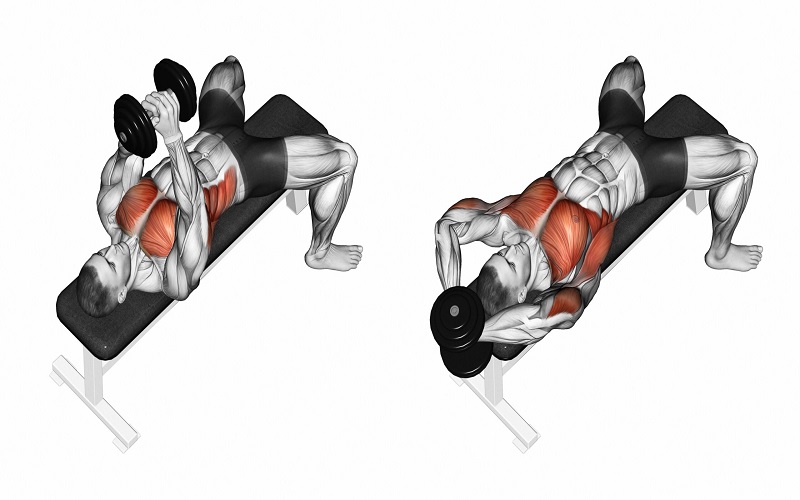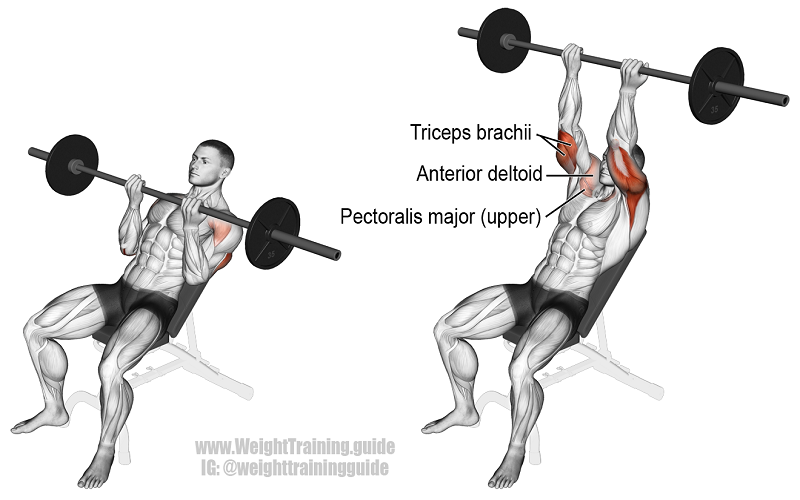Are you aware that your chest contains some of the largest muscles in your body? The chest has the pectoralis muscles that control and move the arms. Daily activities such as washing your hair, opening a door, or getting up and down from the floor heavily engage your chest muscle. As much emphasis is placed on lean legs and a strong core (both of which are essential parts of a fitness program), a comprehensive exercise program also includes chest work.
Cable flies, pullovers, and bench flies are among the best chest isolation exercises. Let’s examine each of them in more detail.
Isolation Exercises
Exercises that isolate only one joint and a few muscles are known as isolation exercises. As opposed to compound exercises, which target more than one joint and muscle group.

Are Isolation Exercises More Important than Compound Exercises?
We take issue with the notion that isolation exercises have no place in any legitimate workout. Here are some reasons why isolation exercises are essential to your fitness.
There is no doubt that isolation exercises are more important than compound exercises. It is our opinion that both are equally important for your workout calendar. Take our word for it. As opposed to compound exercises, isolation exercises develop a single muscle group. It allows you to work all your muscles, thereby preventing muscle imbalance from overtraining. Muscle imbalance could cause injury if one muscle overpowers the other. Imagine your hamstring versus your quadriceps. When one muscle dominates the other, it can result in muscle pulls and tightness. That’s not what we want.
Benefits of Isolation Exercises
You can do isolation exercises to improve recovery, tone muscles, and correct muscle imbalance. Combining isolation exercises with compound weight lifting exercises is a wonderful complement. It’s important to isolate muscles from both sides of the body. In other words, if your workout routine consists of an isolation exercise involving bicep curls on your right side, you need to make sure you do those bicep curls on your left side.
Every workout program should include isolation exercises. The benefits of compound exercises extend to multiple muscle groups, whereas isolation exercises target only one group of muscles. Imagine you are rehabbing a specific muscle, so you need to focus on it.
In an age when there are so many ways to exercise, it’s essential to go back to the basics once in a while. Exercises that isolate one muscle group at a time are some of the most fundamental activities because they allow you to give them your full attention and focus. Today, we’ll explore the benefits of isolated exercises.
· Focus on Form
Isolation exercises can allow you to focus on only one muscle group at a time. You can find focus and power through isolation exercises through your body’s range of motion and hone in on the proper form.
Muscles can grow and strengthen faster when you do things quickly and target multiple muscle groups. However, proper form can also be overlooked. This is where isolated exercises come into play. If you focus on a particular area of your body, you will notice where you can improve your form and where you may have overcompensated in other sites. You can find video demonstrations online or work with a trained fitness or health professional to correct your form.
· Aim for a Specific Muscle Group
When you want to build a specific muscle group, a sound isolation exercise will be your best friend. Using isolation exercises allows you to isolate one specific muscle more effectively than those involving compound exercises.
· Correct Muscle Imbalances Following Injury
It is common to use isolation exercises during physical therapy to help people gain strength in weak areas of their bodies. The muscles in your wrist and arm will become more vulnerable compared to the rest of your body if you break your wrist and have a cast for six weeks. By focusing on strengthening the weak arm, such as bicep curls or wrist circles, you can get the wrist back to par with everything else in your body.
· Restore Harmony and Balance to the Body
You will feel great when all of your muscles are in balance with each other. Our bodies are all different, so this will look different for everyone. It is essential to understand your body’s workings, what it does every day, and to find health-related goals you wish to achieve to structure your workout routines and lifestyle in the best way.
Therefore, it is crucial to be aware of how the muscle group you are targeting relates to the rest of your body. Exercises that isolate your muscles risk over-strengthening some parts while neglecting others, which may have the opposite effect and cause new body imbalances.
· Reduce the Time Between Workouts
To reduce the downtime between workout sessions, you can use the “rotation method” for isolation exercises. After working your muscles to their limit, you must rest and recover before working the same muscle again. You’re more likely to sustain an injury without rest and recovery days in your schedule. The healthiest and safest way to become fit is to listen to your body.
By rotating which muscles you work each day, you are able to reduce your required downtime, letting muscles that need to rest. So even though you go to the gym, you won’t be strengthening a recovering muscle, so there is less chance of injury or over training. If you’re a person who loves consistency and needs a routine to get to the gym regularly, this can be an excellent method for you.
There are a lot of compound exercises like bench presses and push-ups that require multiple joints. Since this involves several muscle groups, it is called a compound movement.
What about the isolation exercises, which are a range of motion targeting a single muscle group? In this article, we will show you some chest isolation exercises that let your chest muscle do all the work and leave other muscles, like the triceps and shoulders, to be less active, which are the assistant muscles during compound movements like the bench press.
List of Chest Isolation Exercises
In addition to the barbell bench press, many other exercises work this one muscle group. Here are a bunch of chest isolation exercises. Check them out!
- Dumbbell Flyes
- Decline Dumbbell Flyes
- Incline Dumbbell Flyes
- Cable Crossovers
- Bodyweight Flyes
- Butterfly Machine
- Cable Iron Cross
- Incline Cable Flyes
- Decline Cable Flyes
- Single-Arm Cable Crossover
- Flat Bench Cable Flyes
- Low Cable Crossover
- Single-Arm Dumbbell Bench Press
- Cable Chest Press
- Incline Cable Chest Press
- Decline Cable Chest Press
Top Best Chest Isolation Exercises
From ancient Greek and Roman (and admittedly narcissistic) times forward, a well-defined chest has been regarded as a classic physical ideal.
Strong pectorals are symbolic of masculinity for men. Despite its simplicity, the bench press has proven to be the most challenging chest isolation exercise ever since someone figured out how to form iron into handy circles that could be attached to long metal poles. Let’s take a look at top best chest isolation exercises.

1. Dumbbell Pullover
Targeted muscle groups: pectorals, latissimus dorsi, serratus
How to do: Place your feet flat on the floor and lie on a bench with your upper back, head, and neck supported. Extend your arms above your head while holding a dumbbell. As you lower the dumbbell backward, maintain a slight bend in your elbows until your elbows are aligned with your ears. Stretch as far as you can without bending your elbows, then flex through your lats and chest to reverse direction and bring the dumbbell back in front of you.
2. Push-Up
Targeted muscles: pectorals (Note that the emphasis can be altered depending on your stance: if you place your feet on the floor with your hands on a bench, you will target the mid pecs; if you place your feet on the bench with your hands on it, you will target the lower pecs.)
Step one for this simple chest isolation exercise: Lie on your back with your feet, your toes on the floor (like a plank position), with your hands wider than shoulder-width, flat on the floor, and your elbows extended. Lower yourself with a neutral head and tight abs, bending your elbows until your upper chest rests gently on the ground, then press through your palms to straighten your arms again.
3. Decline Bench Press
Targeted Muscles: lower pecs
How-To: Lie down on a decline bench. As you bend your knees and tie your feet behind roller pads, ensure your torso is fully supported from head to hips. Grab the bar with an overhand grip. Bring the bar towards your chest by bending your arms. Extend your arms forcefully once the bar reaches chest level and return it to the starting position.
4. Cable Crossover
Main Areas Targeted: inner pecs, lower pecs
How-To: Stand in the center of a cable-crossing station with your feet staggered, knees bent and your focus forward, grasp the D-handles attached to the upper pulleys. Keeping your palms facing down and arms slightly bent, flex your pecs to draw the handles together and down, meeting below your waist. Maintain your elbow position throughout the movement. Let the handles return slowly to the starting position after a short peak contraction. Do not touch the weight stacks while performing reps.
5. Dumbbell Bench Press
Targeted Muscles: middle pecs.
How-To: Place both dumbbells outside your shoulders while lying on a bench with your feet flat on the floor. Slowly bend your elbows to lower the dumbbells to a point every inch or so above your upper-middle chest after you have lifted them toward the ceiling.
6. Incline Dumbbell Flye
Targeted Muscles: upper pecs
How-To:
- For the starting position, put your feet flat on the floor and recline the bench angle at a 30 to 45 degrees.
- Hold a dumbbell in each hand, bend your elbows slightly, and then extend your arms above your chest.
- Drop the dumbbells slowly and arc them slowly to your sides.
- Stop the motion as soon as your elbows reach shoulder level and reverse it.
7. Incline Bench Press
Main Area Targeted: upper pecs.
How-To:
- Put your feet flat on the floor and lie on an incline bench set at the 30 to 45 degrees incline angles.
- Grab the barbell with a wide overhand grip, holding it directly over your upper pecs, and unrack it.
- Drop the bar slowly to your upper chest, touching it down for a brief count, then powerfully press it back to full elbow extension.

8. Reverse-Grip Bench Press
Main Areas Targeted: middle and upper pecs
How-To: Place your feet flat on the floor and lie down on a bench. Then, instead of using your regular overhand grip to bench press, rest the bar on your abs and grip the bar with an underhand grip wider than your shoulder width. Push the bar up, driving the weight away from you until you are almost in a position to lock out your elbows. To return the bar to its original position, bend your elbows and allow it to touch your upper abs before pressing it again.
9. Bench Press
Main Area Targeted: middle pecs.
How-To: It’s performed similarly to a reverse-grip bench, but with one noticeable difference: You’ll track the bar over your lower abs rather than your upper pecs.
Upper Chest Workout Routines for Men
The possibilities for chest day exercises are endless, but you probably don’t want to spend your Monday doing them all. Developing a muscular upper chest can be difficult, so we’ve compared the best chest isolation exercises to help you.
The goal of chest isolation exercises for advanced bodybuilders is to target muscles that are not being worked to their full potential. Mainly when performed in supersets (two or more consecutive chest isolation exercises), chest isolation exercises can help build more definition in areas that were missed by compound exercises. These upper chest isolation exercises can work well for men:
- Barbell Bench Press
- Dumbbell Bench Press
- Incline Bench Press
- Decline Press
- Machine Chest Press
- Push-Up
- Dip
- Chest Fly
- Dumbbell Pull-Over
- Machine Fly
Remember: it’s important to train hard, but you must also train smart. So, create a routine chest day plan with chest isolation exercises that most work for your body!
Upper Chest Workout at Home for Women
According to fitness experts, keeping our posture and balancing our upper body depends on the pectoral muscles. Good posture facilitates digestion, breathing, and blood circulation. A toned chest will also increase the strength of your shoulders and arms, so you’ll be able to pick up groceries and carry your baby more easily. Exercise works not only our upper chests but also our backs, shoulders, and arms. Try these chest isolation exercises:
- Pushup
- Lying Chest Fly
- Plank Shoulder Taps
- Standard Chest Press
- Narrow Chest Press
- Incline Chest Press
- Hook Punches
- Plank Rows
- Chest Squeeze
- Resistance Band Arm Pulses
The Best Chest Exercises According To Experts on HappyTrainer
We think the following are the “best chest isolation exercises” out of all the exercises you can do to on your chest day:
- Barbell Bench Press
- Dumbbell Bench Press
- Weighted Dips
A barbell bench press on an incline and a dumbbell bench press on a neutral plane is the best chest isolation exercises.
Performing these chest exercises will put maximum stress on your pecs while also engaging your arms and core, giving outstanding results quickly.
Why not get started now? Choose the chest isolation exercises that appeals to you the most from this list! Put your hands to work and start building your dream chest.
Final Words
This was a list of chest isolation exercises that are best for your chest day calander. These exercises help you build more chest size and definition. If your main goal is to develop strength and size, you should perform compound chest exercises like bench presses and pushups. Combining compound exercises with chest isolation exercises will help you achieve your goals.
It would help if you prioritized the muscles you must work on the most when designing your workout chest day program. For instance, if your goal is to improve your bench press, then you should perform the bench press and isolate it with cable flies. It’s essential to design your workout routines based on your goals and fitness level.
Don’t forget to listen to your body when performing chest isolation exercises. To prevent shoulder injury, focus on good form and technique, and stop exercising if you feel pain. Get in touch with your physician to request a referral to a physical therapist if you believe you have been injured while exercising.
Please share this article with your friends and family if you found it helpful. Let me know by commenting below if you want me to write an essay about any other related topic.
